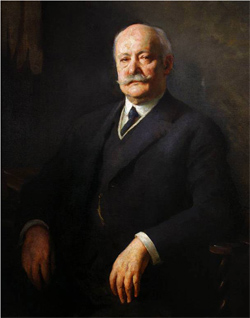Asthma Is an Allergic Disease

Portrait of Samuel Meltzer by Adolphe Borie
At a time when physicians commonly considered asthma to be a disease of the central nervous system—or even a neurosis peculiar to the wealthy—Samuel Meltzer (1851-1920) formulated the modern understanding of asthma as an immunological response. Meltzer applied the then-new concept of anaphylaxis, or hypersensitivity, to explain asthma. Experiments in his laboratory detailing the physiological reaction of anaphylaxis in guinea pigs supported his claims.
Meltzer publicized his views in a landmark address before the Association of American Physicians in 1910. Earlier researchers had argued that stimulation of the vagus nerve caused muscle contraction and narrowing of the airways, or bronchi, in asthma. But John Auer and Paul Lewis, working in Meltzer's laboratory, had shown that an anaphylactic attack could take place in animals in which the nerve had been cut, or that had a destroyed central nervous system, indicating, rather, that the peripheral nervous system was involved. They used horse serum to first sensitize the animals, and then bring on an anaphylactic response. Meltzer noted the similarities between the animals' reactions and asthma in humans, and also compared asthma to hay fever. He concluded, "...an asthmatic is an individual who is sensitized to a definite substance and an asthmatic attack sets in every time this substance manages in some way to enter into the circulation of that individual."
Samuel Meltzer was born in Russia and trained in Germany, receiving the MD at the University of Berlin in 1882. He emigrated to the United States in 1883. He initially set up a private practice, and paid for the use of research facilities in William H. Welch's laboratory at Bellevue Hospital and Curtis and Prudden's laboratory at the College of Physicians and Surgeons at Columbia University. In 1903 Samuel Flexner invited Meltzer to join the Rockefeller Institute. Meltzer founded or cofounded a remarkable number of professional organizations, including the Harvey Society, the American Society for Clinical Investigation, the Federation of American Societies for Experimental Biology (FASEB), the Society for Experimental Biology and Medicine, and the American Association for Thoracic Surgery; he also served as president of each of these societies, as well as the American Gastroenterology Association, the American Physiological Society, and the Association of American Physicians.
John Auer received the BS from Michigan University (1898) and the MD from The Johns Hopkins University Medical School (1902). In 1903 he joined Samuel J. Meltzer's laboratory at the Rockefeller Institute. Auer was married to Meltzer's daughter Clara. He became professor of pharmacology at the St. Louis University School of Medicine in 1921. In addition to his work with Meltzer, Auer is remembered for his discovery of Auer bodies, the rod-shaped structures found in the cytoplasm of blast cells in acute myeloid leukemia.
Selected Publications
Auer J and Lewis PA. The physiology of the immediate reaction of anaphylaxis in the guinea pig. J Exp Med, 1910, 12: 151-175
http://jem.rupress.org/cgi/reprint/12/2/151
Meltzer SJ. Bronchial asthma as a phenomenon of anaphylaxis. JAMA, 1910, 55: 1021-1024
Further Reading
Keeney E. The history of asthma from Hippocrates to Meltzer. J Allergy Clin Immunol, 1964, 35: 215-226
Meltzer A. Breath of Life: The Life and Works of Dr. Samuel James Meltzer. New York: Vantage, 1993, pp. 220-222
Mitman G. Breathing Space: How Allergies Shape Our Lives and Landscapes. New Haven: Yale Univ Press, 2007
Links
National Library of Medicine Exhibition: Breath of Life
http://www.nlm.nih.gov/hmd/breath/breathhome.html
